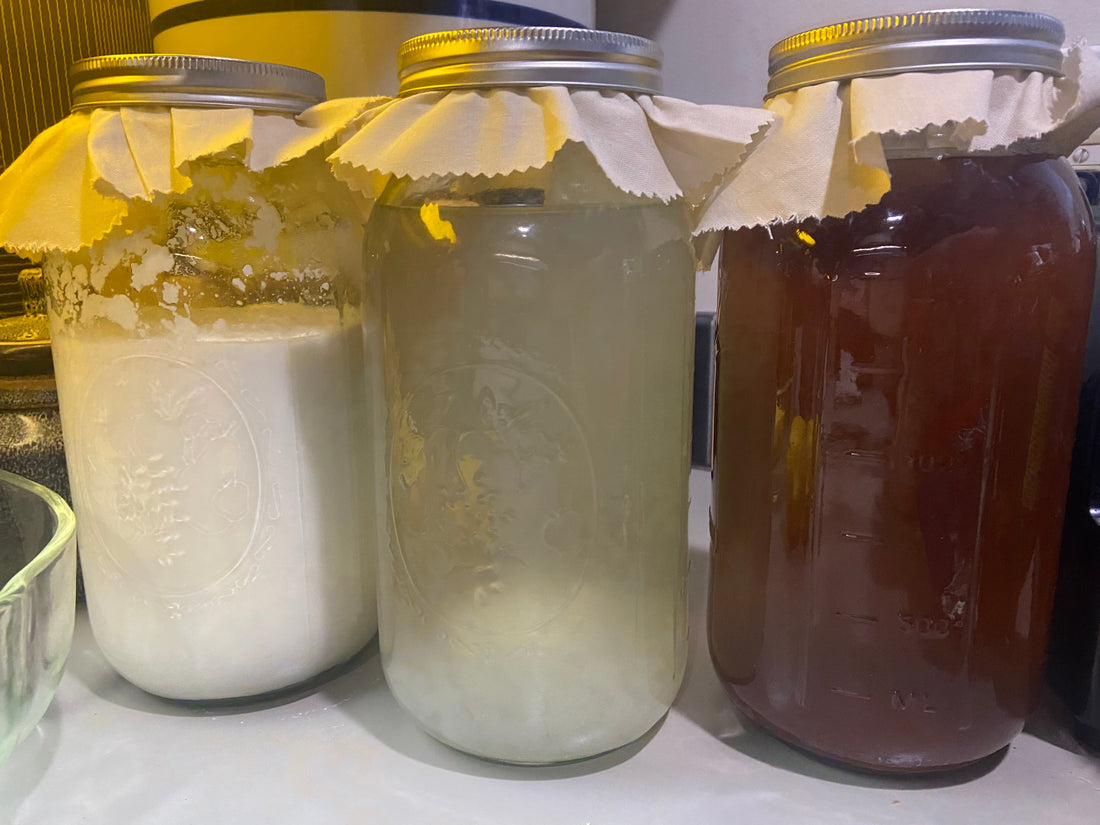
A Bubbly Case Study: Water Kefir, Milk Kefir & Kombucha
RoniLynn ShroutShare
A Bubbly Investigation into the Three Fermentation Amigos
Abstract
In the name of science (and a healthy dose of culinary curiosity), I embarked on a quest to produce three fermented beverages: water kefir, milk kefir, and kombucha. This “case study” documents my journey from wide-eyed newbie to proud parent of fizzing microbes—and all the triumphs, explosions, and face-puckering taste tests in between.
Introduction
They say you can learn a lot about yourself by adopting a pet. In my case, I decided to adopt three sets of tiny pets simultaneously—bacteria and yeast cultures—whose sole purpose in life is to create tangy, probiotic-packed drinks for my daily hydration/entertainment needs.
This story is not just about fermentation. It’s about forging an alliance with mysterious, possibly alien, micro-organisms and then trying desperately not to kill them. Strap in and sip some kefir (or kombucha) as I unfold this saga of fizz, flavor, and occasional fermented fiascos.
The Subjects of Study
1. Water Kefir (The Sparkly Sweetheart)
- Culture Name: Tibicos grains (a.k.a. water kefir grains)
- Appearance: Tiny, translucent, gelatinous crystals—like gummy bear bits that took a vow of transparency.
- Personality: Friendly, fruity, and flexible. These grains can transform plain sugar water into a lightly sweet, gently carbonated refresher.
2. Milk Kefir (The Creamy Daredevil)
- Culture Name: Milk kefir grains
- Appearance: Cauliflower-like florets (which, coincidentally, smell more like sour milk than a vegetable).
- Personality: Tangy, tenacious, and occasionally moody—milk kefir can thicken up too fast or too slow depending on its mood and the weather.
3. Kombucha (The Tea-Based Diva)
- Culture Name: SCOBY (Symbiotic Culture Of Bacteria and Yeast)
- Appearance: A rubbery, disk-shaped pancake that might star in a low-budget sci-fi movie.
- Personality: Fizz-forward, sweet yet tart, and never shy about letting you know if you’ve kept it waiting too long. A total diva if not given the correct blend of sweet tea and some breathing room.
Methodology
Step 1: Acquiring Cultures
Like any diligent researcher, I first had to source my living subjects. Water kefir grains and milk kefir grains arrived in cozy, labeled bags from a reputable fermentation supplier, while the kombucha SCOBY came from a friend who insisted I “treat it like a newborn.” (I decided not to mention how seldom I babysit…)
Step 2: Setting Up the Lab (a.k.a. My Kitchen Counter)
I designated a corner of my kitchen as the “fermentation station,” complete with mason jars, breathable cloth covers, rubber bands, a funnel (essential for channeling spills into narrower spills), and a note that read: “Yes, these lumps are SUPPOSED to be alive.”
Step 3: The Brewing & Fermenting Process
Water Kefir
- Sugar-Water Prep: I dissolved about ¼ cup of sugar in a quart of filtered water—no chlorine, because tibicos are snobs about that.
- Grain Introduction: The tibicos grains went in with a flourish.
- Cover & Wait: A cloth cover to keep out fruit flies and dust, and 24–48 hours at room temperature.
- Taste-Testing: When it was slightly tart and mildly sweet, I strained the grains out.
- Second Ferment: I added fresh fruit juice and sealed it in bottles for extra fizz—there may or may not have been an incident where I opened a bottle too eagerly, resulting in a geologically improbable geyser that redecorated my ceiling.
Milk Kefir
- Milk & Grains: I poured about 2 cups of milk (cow’s milk) into a mason jar, dropped in the cauliflower-like grains, and gave it a little swirl.
- Cover & Wait: Again, a breathable cover, 12–24 hours at room temp.
- Check Consistency: When it thickened to something akin to drinkable yogurt, I strained out the grains (very carefully, using a plastic or stainless-steel strainer).
- Taste & Adjust: I discovered that letting it ferment a few extra hours gave it more tang, which I now lovingly refer to as “lip-smack-level sour.” Perfect for smoothies or comedic faces.
Kombucha
- Sweet Tea Base: For a half-gallon batch, I brewed 4 bags of black tea in about 6 cups of water, dissolved ½ cup sugar, and let it cool.
- SCOBY & Starter: Gently slid in the SCOBY, along with about a cup of starter kombucha.
- Fermentation: Covered with cloth, left it alone for 7–10 days, occasionally sneaking a sip to gauge tanginess.
- Second Ferment: After the initial period, I removed the SCOBY, bottled the kombucha with fruit or ginger slices, and let it sit a couple of days for carbonation. I learned to “burp” the bottles daily to prevent any glass-blowing explosive events that might star on a dramatic reality show.
Observations
-
Aromas
- Water Kefir: Mild sweetness, a hint of fermentation funk, and sometimes a bit of fruitiness if second-fermented with berries.
- Milk Kefir: Tart dairy smell, reminiscent of a cheese cave—comforting if you like cheese, slightly alarming if you don’t.
- Kombucha: A sweet-sour vinegary tang that says, “I’m healthy but edgy.”
-
Carbonation Levels
- Water Kefir: Consistently gentle fizz; second fermentation can yield surprisingly champagne-like bubbles if you’re patient.
- Milk Kefir: Very minimal carbonation, more about creaminess than bubbles. However, if sealed improperly, you might open the jar and experience a comedic “kefir pop.”
- Kombucha: The rock star of carbonation. With a bit of sugar in the second ferment, it can go from subtle sparkle to a mini blast off in days.
-
Taste Profiles
- Water Kefir: Lightly sweet, tangy, refreshing—think probiotic “soda” without the sugar overdose.
- Milk Kefir: Tangy, creamy, almost like a pourable Greek yogurt. Perfect in smoothies or with a swirl of honey.
- Kombucha: Sweetly tart tea with a refreshing edge. Stronger as it matures, so taste early and often to find your sweet spot.
-
Emotional Reactions
- Awe: The first time you see grains or a SCOBY transform plain liquids into living, effervescent potions is a bit magical.
- Panic: Realizing that each culture needs to be fed, coddled, and not left on the windowsill to fry in direct sunlight.
- Joyful Giggling: When you pop open a bottle and fssssssstt—the fizz is real!
- Despair (brief): Occasional kitchen explosions can happen. Keep paper towels handy.
Results
Each beverage brought its own brand of satisfaction and comedic mishaps:
- Water Kefir excelled in the “I want a quick, refreshing fizz” category. It’s the simplest to maintain—just keep feeding it fresh sugar water every time you brew a new batch.
- Milk Kefir won the hearts of the “I need my probiotics in a creamy form” crowd. Some days it’s runnier; other days it’s as thick as sour cream, but it’s always a delight in smoothies or as a substitute for buttermilk in pancakes.
- Kombucha became a conversation piece. The SCOBY is both mesmerizing and a little terrifying, but the final product is consistently delicious, especially when you experiment with funky flavor combos like ginger-lime, berry-basil, or apple-cinnamon.
Discussion
From a purely scientific standpoint (and comedic vantage), fermented beverages are a testament to the power of micro-organisms and the synergy between yeast and bacteria. They also demonstrate that not all science experiments end in catastrophic failure—sometimes, they end in a frothy drink that tastes incredible and might even support gut health.
For novices, the biggest hurdle is maintaining the right environment: consistent temperatures, clean equipment, and a watchful eye for contaminants or mold. For comedic relief, the biggest highlight is definitely the unpredictability of carbonation—watching unsuspecting house guests jump when a jar hisses at them never gets old.
Conclusion
My triple-fermentation experiment confirmed that each beverage has a unique personality:
- Water Kefir is your laid-back friend who shows up in flip-flops and always has a fizzy story to tell.
- Milk Kefir is your brash but lovable aunt who’s sour at first but warms up with a bit of sweetening.
- Kombucha is that adventurous pal who loves to push boundaries—sometimes literally, right through the bottle cap.
If you’re new to fermentation, pick the beverage that makes you say “That sounds fun!” (or “That seems least likely to explode in my kitchen!”). Or go ahead—try all three like I did. Despite occasional mishaps, you’ll gain a healthy respect for these invisible workhorses that can transform sugar, milk, and tea into some of the tastiest, healthiest, and—yes—most entertaining beverages you’ll ever brew.
Final Note
When you inevitably fall down the rabbit hole of fermentation, remember:
- Keep everything as clean as your Aunt Martha’s fine china.
- Burp your bottles to avoid turning your kitchen into a sticky ocean of fizz.
- Don’t panic if your SCOBY grows an extra layer or your grains multiply. That’s a sign your cultures love you!
- Embrace the tang! Because once you develop a taste for it, plain old soda or milk may never be the same again.
Now, raise a glass of your favorite ferment and toast to the weird, wonderful world of living beverages!







